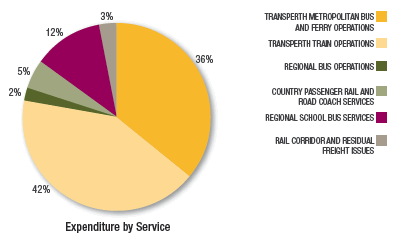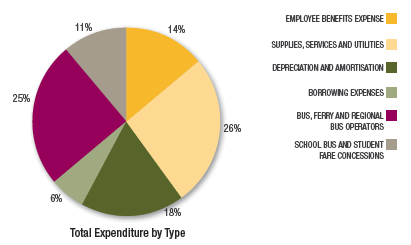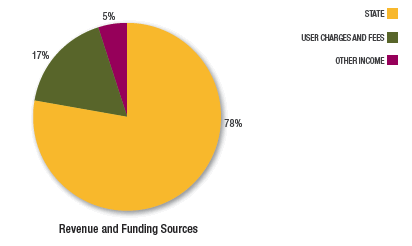Service and Financial Achievements
During the financial year 2009/10, the PTA has delivered public transport services worth $882.7 million to the people of Western Australia. The graph below shows how these funds were spent across each service. Refer to the individual sections of Review of Performance by mode for further details on expenditure by services. Total revenue and funding received during the year amounted to $899.3 million.Financial Targets: Actuals compared to budget targets
The following table provides a comparison of the financial targets and outcomes against criteria included in the Resource Agreement between the Chief Executive Officer, Minister for Transport and the Treasurer.
| 2009-10 Target (1) $’000 |
2009-10 Actual $’000 |
Variation(2) $’000 |
||
|---|---|---|---|---|
| Total costs of services | 866,141 | 882,693 | -16,552 | Note 2.1 |
| Net cost of services | 697,315 | 684,919 | 12,396 | Note 2.2 |
| Total Equity | 3,309,431 | 4,477,030 | -1,167,599 | Note 2.3 |
| Net increase/(decrease) in cash held | -13,150 | -7,182 | 5,968 | Note 2.4 |
| Number of FTE’s | Number of FTE’s | Number of FTE’s | ||
| Approved Full Time equivalent | 1,463 | 1,393 | 70 | Note 2.5 |
Notes
1. As specified in the 2009/10 budget statements
2. Explanation of variations:
(2.1) Increase in Total Cost of Services reflects Cabinet and EERC budget approvals during 2009/10, the increase is mainly due to:
- Costs related to recoverable external works $ 5.2 million;
- Fuel cost increases $ 2.4 million;
- Legal costs $ 3.7 million, funded in a previous year;
- Grain freight Stage 1 expenditure $ 5.2 million;
- Bus Stop Accessibility Program $ 0.6 million.
(2.2) Decrease in net cost of services reflects increases in total cost of services offset by a $ 20.9 million increase in revenue, mainly due to:
- Fare revenue $ 3.9 million;
- Rental revenue $ 2.9 million;
- Revenue related to the Goongoonup rail bridge and the Mirrabooka bus station $10.1 million;
- Revenue from infringements and service contributions $ 4.0 million.
(2.3) The variation is mainly due to revaluation of freight network infrastructure.
(2.4) The movement in cash is mainly due to cash balances held for the Grain Freight stage 1 program.
(2.5) The variation to the approved FTE staff level is mainly due to the difficulty in recruiting transit officers. Train security was maintained by use of CCTV and contract security services.
Summary of Key Peformance Indicators: Actual compared to budget targets
| 2009-10 Target | 2009-10 Actual | Variation | |
|---|---|---|---|
Outcome: Accessible, Reliable and Safe Public Transport System.Key Effectiveness Indicators |
|||
|
Use of public transport - passengers per service kilometre : |
|||
| • metropolitan bus services | 1.43 | 1.43 | 0.00 |
| • metropolitan train services (a) | 3.46 | 4.15 | 0.69 |
| • metropolitan ferry services | 13.78 | 13.43 | -0.35 |
| • regional bus services | 0.853 | 1.002 | 0.149 |
| • country passenger rail services | 0.27 | 0.242 | -0.028 |
| • country passenger road coach services | 0.07 | 0.067 | -0.003 |
|
Accessible Public Transport: The proportion of street addresses within the Perth Public Transport Area which are within 500 metres of a Transperth stop providing an acceptable level of service |
81% | 82.89% | 1.89% |
|
Metropolitan and regional passenger services reliability: |
|||
| • bus services within four minutes of scheduled time | 85% | 85.54% | 0.54% |
| • train arriving within four minutes of scheduled time | 95% | 95.90% | 0.90% |
| • ferries arriving within three minutes of scheduled time | 98% | 98.39% | 0.39% |
|
Country passenger rail and road coach services reliability: |
|||
| • Prospector arriving within 15 minutes of scheduled time (b) | 90% | 72% | -18.00% |
| • Australind arriving within 10 minutes of scheduled time | 90% | 95% | 5.00% |
| • MerredinLink arriving within 10 minutes of scheduled time | 95% | 87% | -8.00% |
| • AvonLink arriving within 10 minutes of scheduled time | 95% | 98% | 3.00% |
| • Road Coaches arriving within 10 minutes of scheduled time | 95% | 97% | 2.00% |
|
Regional school bus services reliability: |
|||
| drop off no less than 10 minutes before the school starts and pick up within 10 minutes of school ending | 97% | 97% | 0% |
|
Level of overall customer satisfaction - customer satisfaction index: |
|||
| • metropolitan bus services | 80% | 81% | 1% |
| • metropolitan train services | 92% | 93% | 1% |
| • metropolitan ferry services | 98% | 96% | -2% |
| • country passenger rail and road coach services | 92% | 90% | -2% |
|
Customer perception of safety - independent external surveys: |
|||
| • train station - daytime | 96% | 98% | 2% |
| • on-board train - daytime | 97% | 98% | 1% |
| • train station - night-time | 65% | 70% | 5% |
| • on-board train - night-time | 75% | 75% | 0% |
| • bus station - daytime | 95% | 96% | 1% |
| • on-board bus - daytime | 99% | 98% | -1% |
| • bus station - night-time | 65% | 70% | 5% |
| • on-board bus - night-time | 80% | 79% | -1% |
|
Level of notifiable safety occurrences - notifiable occurrences: |
|||
| • Category A: occurrences per million passenger boardings (c) | 0.34 | 0.23 | -0.11 |
| • Category A: occurrences per million train kilometres (c) | 1.11 | 0.86 | -0.25 |
| • Category B: occurrences per million passenger boardings | 9.32 | 8.19 | -1.13 |
| • Category B: occurrences per million train kilometres | 30.50 | 30.74 | 0.24 |
| • Regional school bus services: notifiable occurrences (accidents) reported each school year(d) | 13 | 17 | 4 |
|
Outcome: Protection of the long term functionality of the rail corridor and railway infrastructure: |
|||
| • Number of lease breaches | Nil | Nil | Nil |
Key Efficiency Indicators |
|||
|
Service 1 : Metropolitan and Regional Passenger Services |
|||
| Average cost per passenger kilometre | |||
| • Transperth bus operations (e) | $0.63 | $0.76 | $0.13 |
| • Transperth train operations (f) | $0.46 | $0.41 | -$0.05 |
| • Transperth ferry operations | $1.24 | $1.22 | -$0.02 |
| Average cost per 1,000 place kilometres | |||
| • Regional bus services | $74.62 | $80.09 | $5.47 |
| Total passenger place kilometres (millions) | |||
| • Regional bus services | 185.2 | 190.5 | 5.3 |
|
Service 2 : Country Passenger Rail and Road Coach Services |
|||
| Average cost per passenger kilometre | |||
| • Transwa rail | $ 0.41 | $0.44 | $0.03 |
| • Transwa road coaches | $ 0.22 | $0.20 | - $0.02 |
|
Service 3: Regional School Bus Services |
|||
| Average cost per contracted kilometre: student bus services | $3.39 | $3.27 | -$0.12 |
|
Service 4: Rail Corridor and Residual Freight Issues |
|||
| Total cost of managing the rail freight corridor and residual freight issues(g) | $26,846,000 | $ 29,681,000 | $2,835,000 |
Note: For more explanations on the variation, please refer to the section Audited Key Performance Indicators.
- Transperth Trains achieved a growth in patronage in 2009/10 reaching 56.4 million, 2.0% above target.
- The 2009/10 on time running result for the Prospector was below target as a result of disruptions in services due to track works, and train crossing delays due to increased traffic.
- Category ‘A’ incidents per million passenger boardings and per million train kilometres were 32% and 23% lower than target.
- Regional school bus services notifiable occurrences were above target; approximately 65% of the accident cases occurred through no fault of the school bus driver. No fatalities were recorded.
- The Transperth Bus services cost per passenger kilometre in 2009/10 rose significantly above target mainly due to the significant decrease in passenger kilometres. The average trip length per passenger decreased by 15% from 6.6 kilometres to 5.6 kilometre.
- The Transperth Trains services cost per passenger kilometre in 2009/10 decreased significantly below target mainly due to the significant increase in passenger kilometres by 16.6% compared to the previous year. The average trip length per passenger surpassed the target by 12% to 17.69 kilometre per passenger.
- The cost of managing the rail corridor and residual freight issues in 2009/10 was higher than target by 10.56% due to additional costs associated with revaluing the freight network and the assessment of the grain freight network.


